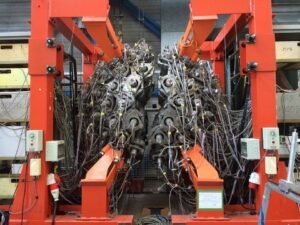What is an Electroscope
By: Pranjal Gautam


As a science student, you must have heard of the electroscope. So, what is an electroscope? It is an early scientific instrument used to detect the presence of electric charge on a body. We can observe that the object is charged or not by using an electroscope as it shows the divergence of aluminum leaves.
The first electroscope was a pivoted needle (called the Versorium), invented by British physician William Gilbert around 1600. The pith-ball electroscope and the gold-leaf electroscope are two classical types of electroscope that are still used in physics education to demonstrate the principles of electrostatics.
Gold Leaf Electroscope

| Gold leaf electroscope was developed in 1787 by British clergyman and physicist Abraham Bennet as a more sensitive instrument than pith ball instrument or straw blade electroscopes then in use. It consists of a vertical metal rod, usually brass, from the tip of the two parallel strips of thin flexible gold leaf, a disk or ball terminal is attached to the top of the rod, where the charge to be tested is applied. When the metal terminal is touched with a charged object, the gold leaves spread apart in an inverted ‘V’. This often because of a number of the charge on the object is conducted through the terminal and metal rod to the leaves. |

Pith Ball electroscope
Pith ball electroscope was invented by British schoolmaster and physicist John Canton in 1754. He used a simple thread, which would be attached nearby charged body. This was the first improvement in William gilbert Versorium.
It consists of one or two small balls of a lightweight non-conductive substance, originally a spongy plant material called Pith with silk and linen thread from the insulated stand. Tiberius Cavallo made an electroscope in 1770 with pith balls at the end of silver wires.
Coulombs Law

K =constant
r = separation of distance
q1& q2= Charges
What is coulomb’s Law?
Coulomb’s law states that the electrical force between two charged objects is directly proportional to the product of the quantity of charge on the objects and inversely proportional to the square of the separation distance between the two objects.
Like charges repel and unlike charge attract each other so the arm of the electroscope swings out, as in the electroscope on the right. The larger the charge, the more the arm diverges. To get a more quantitative measure of charge than we can get with an electroscope, here we use Coulomb’s law.
How to make an electroscope
Aim: To check the working of an electroscope
Material required:

- Empty glass bottle
- Aluminum Foil
- Copper wire
- A piece of cardboard
- Electric tape
Procedure: –
- Take an empty glass bottle and cut the cardboard in the shape of the mouth of the glass bottle (electroscope).
- Pierce a hole in the cardboard and fix the copper wire and make the hook-like structure at one end and spring-like structure on another end.
- Cut two aluminum foil leaves as shown and insert them in the hook like the structure of copper wire.

- Fix the cardboard with copper wire at the mouth of a glass bottle.
- Seal the mouth of a glass bottle (electroscope) with the help of electric tape.
- Now your electroscope s ready.

Working of Electroscope
- Take a plastic scale and rub it against your head for 10 seconds.
- Now touch your scale on the spring-like structure of the electroscope and observes what happens.
- If the leaves of the electroscope show some divergence in their leaves that means the scale has acquired some charge on it. If no divergence means the scale (object) has no charge.





Nice content…..well thought!!!
NOICE.
Nice